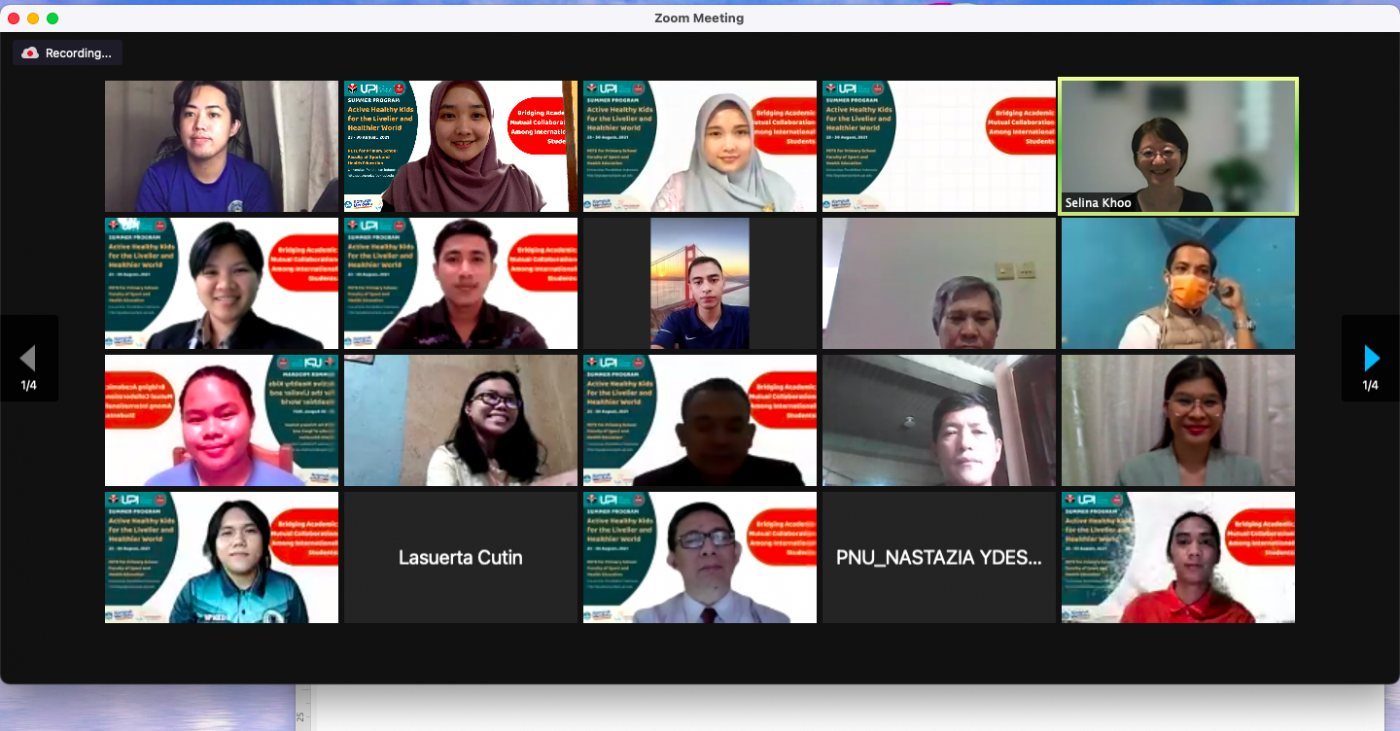The Summer Program for Active Healthy Kids for Livelier and Healthier World has been carried out and officially opened by the Dean of FPOK UPI, Dr. H. Rd, Boyke Mulyana, M.Pd., Monday, August 23, 2021, at 08.00 WIB. . The program, which was initiated and organized by the PETE for ES Study Program in collaboration with Active Healthy Kids Indonesia, will take place in eight days, from 23 to 30 August 2021.
This summer program involved around 60 active participants, the majority of whom consisted of students from abroad, who came from the Southeast Asian region, including from Malaysia and the Philippines, besides from Indonesia. There are also student applicants who come from outside Southeast Asia, namely from Iraq. Participants who registered reached 99 people, with the majority of participants being students from the Philippines.
The opening of the summer program took place solemnly and formally, where the Director of DIA (Directorate International Affairs) UPI, Ahmad Buchori, Ph.D. came to attend and delivered his official remarks. The Director of DIA expressed his appreciation to the PGSD Study Program and the committee, who had taken the initiative to raise the theme of Active Healthy Kids for a Livelier and Healthier World, considering that it was very closely related to current conditions.
According to Achmad Bichori, in the midst of the Covid-19 pandemic, it is alleged that there are many children who are very constrained to actively move to expend their excess energy, and switched to being connoisseurs of electronic devices, thereby increasing their screen time. Thus, this summer program provides a way for more students to be given the task of inviting children in the neighbourhood where they live, to be active and move enthusiastically.
The opening was also attended by one of the foreign instructors, namely Associate Professor Selina Khoo, who came from the University of Malaya, Kuala Lumpur, Malaysia. And the first day of the summer program was indeed the day where she served as an instructor who delivered presentations. Another instructor who will be in charge of this series of programs is Prof. Stephen H.S. Wong, Ph.D., from the Chinese University of Hong Kong, as well as being one of the executive representatives of AHKGA, as well as Assoc. Professor Lisa Barnett, an expert in physical activity and physical literacy from Deakin University, Australia.
The summer program is indeed designed to raise awareness of students from various study programs, to be able to take part in efforts to increase the level of physical activity of children and adolescents, so that they are free from the threat of sedentary behaviour tendencies. The condition of inactivity of children and adolescents is becoming a concern for all parties, especially WHO, which claims that the inactivity of the world community has become the number four threat that causes death.
In the absence of the COVID-19 pandemic itself, recent research suggests that death from physical inactivity ranks fourth after high blood pressure, tobacco use and high blood glucose, and complements the threat from being overweight and obese (World Health Organization (World Health Organization). WHO), 2009, pV).
In 2008, physical inactivity was estimated to be responsible for 9% of premature deaths or more than 5.3 million deaths worldwide (Lee et al., 2012). Based on these results, physical activity has been described as one of the “biggest public health problems of the 21st century” (Blair, 2009; Trost et al., 2014). The global prevalence of physical inactivity was estimated at 31.1% for adults from 105 countries in 2012, (Hallal et al., 2012) and 81% for adolescents (11 to 17 years) in 2010 (WHO, 2014)
As has been acknowledged very well, being active has become the basic standard for optimal physical, mental, emotional and social growth of children, which is a basic need for children. But in reality, economic growth and progress in development have eroded children’s right to be active, because apart from the disappearance of needed public space, also because academic demands in the field of education demand too much time for children to study ‘while still and not moving.’ At the same time, schools and the government have not compensated for this lack of movement with policies that compensate for the shortage.

 indonesia
indonesia

